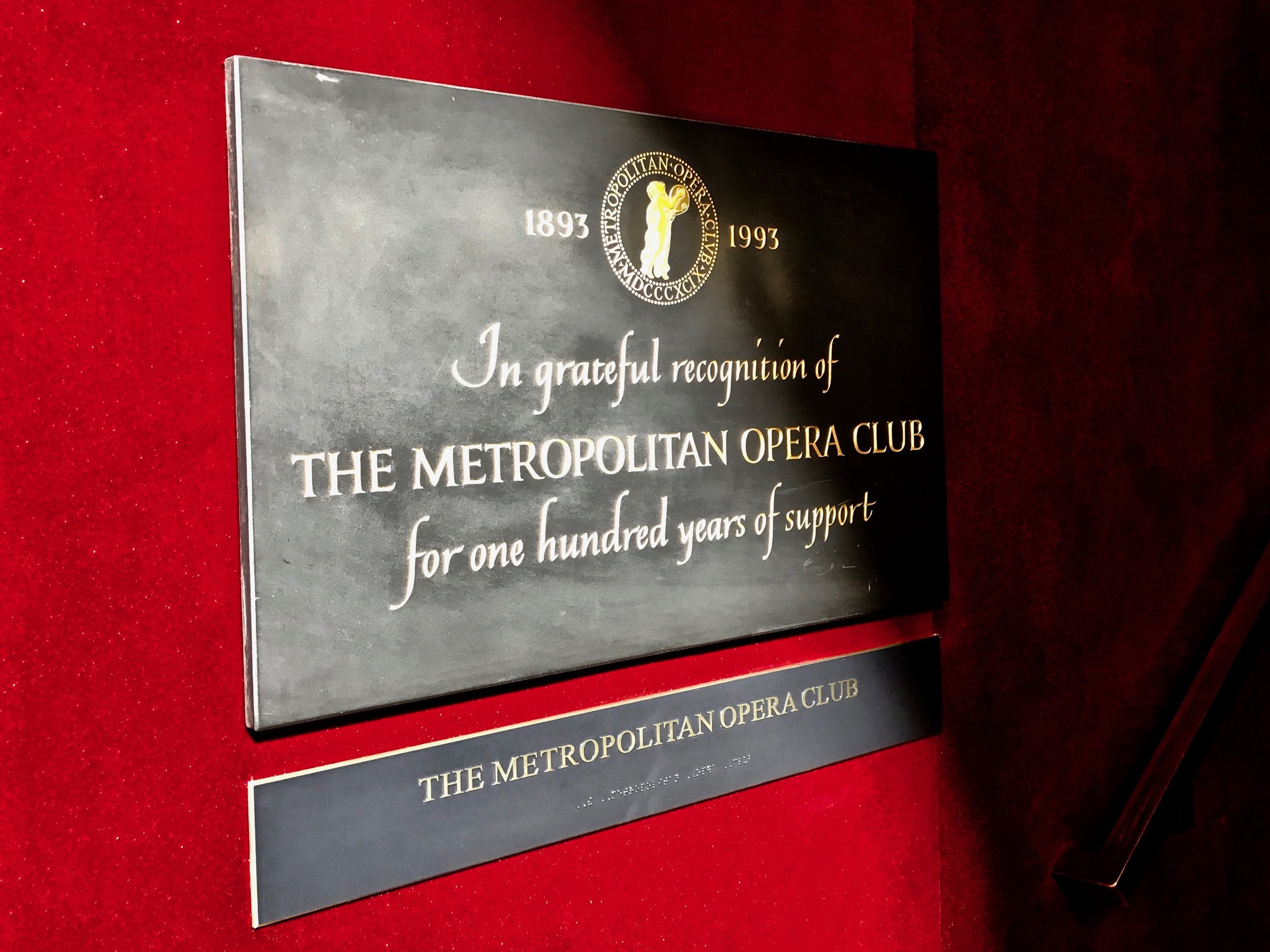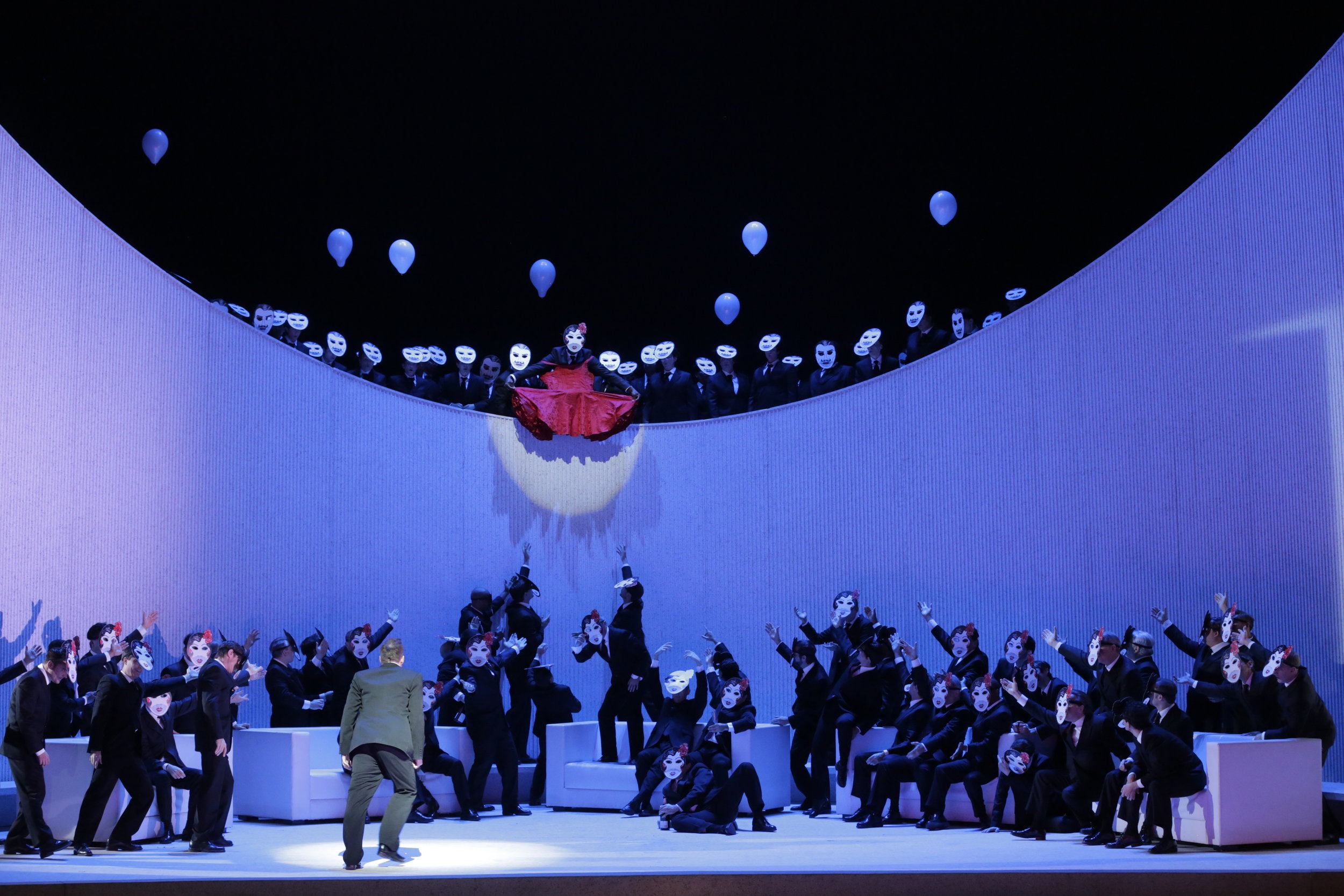The Metropolitan Opera Club--Opera's Biggest Fans
I didn’t know the Metropolitan Opera Club existed until just a few years ago, but they’ve had a lasting presence in the history of the Metropolitan Opera for over 125 years now. The Metropolitan Opera Club consider themselves opera’s biggest fans, and have cultivated relationships with principal singers, members of the Orchestra, and to our delight, members of the Chorus. Club members see multiple performances at the Met, but members also travel to opera houses around the world (I’ve heard people talk about visiting Santa Fe Opera, The Bayreuth Festival, and Vienna State Opera) throughout the year for even more performances. The Chorus loves our MOC friends, but few know who they are.
In 1893 at the “Old Met”, a private gentlemen's club was founded called The Vaudeville Club. It boasted a private room on the Grand Tier level near a box of about 50 seats that they reserved for performances. Apparently, they spent their intermissions visiting female operagoers and enjoying private performances by vaudeville acts like Vesta Victoria. According to Martin Mayer’s “The Met: One Hundred Years of Grand Opera”:
It was also possible to get a drink, or several, in the club’s room across the corridor. “Memberships were high,” wrote the Club’s historian affectionately in 1949, “and so, at times, were members.”
Shortly after its formation, the club changed its name to the Metropolitan Opera Club. More importantly, they changed their focus from intermission shenanigans to the art form of opera. They opened their membership to women in the 1980’s, and their mission currently concentrates on cultivating vocal and instrumental music and social engagement among its members.
The Club now resides in a private restaurant on the Dress Circle level of the Met, complete with a chef and headwaiter, and is accessed by a private elevator in the Met’s lobby. The elegant space was designed by Angelo Donghia in 1966. The room features a silver-leaf ceiling and a chandelier, and on the bar sits a bronze bust of tenor Giovanni Martinelli. When I first visited members John Brewer and Susan Clearwater in the Club, I was struck by the chic decor and “old-school” elegance. It’s exactly the type of room you'd expect for an institution with its kind of history. But the members are friendly and engaging, with unrivaled knowledge of opera.
I routinely feel underdressed when I’m visiting the Club. One tradition they haven’t changed over the years is wearing formal attire for performances and Club dinners. Known as the “Penguins” by the average opera patron, members wear white tie and tails and gowns for opening nights and turn to black tie for midweek performances. If you see the Penguins on the Dress Circle level, say hello — they’re proud of the moniker!
The Chorus’ association with the MOC began in 2017 with a presentation of the choruses from La Traviata, with the help of MOC members and friends John Brewer and Susan Clearwater. We organized the presentation around the particulars of executing the score with the right style and character needed for the piece, complete with a demonstration of what it was like to sing wearing the Act II masks from the Willy Decker production. The following year saw a La Bohème presentation, and in February of this year we explored Carmen.
Each of these operas is very familiar to Club members — they see over 130 performances a season, after all. So we endeavor to make the presentation interesting by inviting our Chorus Master Donald Palumbo to speak about what it takes to prepare each score. The intricacies of each piece are demonstrated by Chorus volunteers singing, say, the “conversational” quality of La Bohème. The Bohème chorus should sound like the busy Café Momus, with voices coming from all around you, but it has to carry in the Metropolitan Opera house full of 3,800 seats.
The selection we sang in our Carmen presentation ran the gamut in terms of character: the Soldiers’ lazy opening “Sur la place”, the sultry yet finely-detailed Habañera (Carmen was played by chorister Stephanie Chigas), the women’s frantic “fight” scene and a Toreador song with chorister Ned Hanlon as Escamillo. Each opera presents issues for choristers, such as “how do I sing this long, legato line while staged to lay on the floor?” or “how can I ‘cheat’ my voice out to the house without sacrificing the action of the scene?” The presentations end with a Q&A session, which can cover topics like backstage drama, staging logistics, old vs. new productions, and our personal backgrounds. We also invite Club members each season to a handful of our musical rehearsals held in List Hall. There, they see the “nitty gritty” of putting together an opera chorus from the ground up.
Club members have a similar relationship with the Orchestra, and are able to hear individual players when they join guest lecturer Maestro Joseph Colaneri for his series of talks for the Club. In his lectures, he’ll detail the history of the opera he’s highlighting, concentrating on historical context, musical or dramatic themes, and the composer’s life or body of work. Sometimes Orchestra members will play a string quartet by the composer, or musical examples from the opera. At one I attended, principal flutist Seth Morris played the gorgeous introduction to “Casta Diva” from Norma, demonstrating how much his melody is really just another vocal line set for flute.
The Club has hosted dinners for various principal singers through the years, presenting them with honorary Club memberships, with Elina Garanca, Sonya Yoncheva, and Piotr Beczala being the most recently honored. The dinner features an interview with Opera News’ Editor in Chief F. Paul Driscoll covering the career and life of each artist prior to an opera performance in the house. Dessert is served during the first intermission, with built-in social time with the artist. This Spring, the Club chose Chorus Master Donald Palumbo for an honorary membership, and a group from the chorus sang the finale of La Clemenza di Tito with choristers singing the solo parts as a surprise performance for Maestro Palumbo and the members.
Although the Club has no affiliation with the Metropolitan Opera Association, you can thank the Club for numerous contributions around the house — they fund revival costs each year (the past few years have included the revivals of Don Giovanni, Madama Butterfly and Anna Bolena), similar contributions for special productions, the purchasing of tickets worth a total of $500,000 each season, with perhaps the most visible donation: the Met’s gold curtain. The MOC funded the 1979 installation of the Scalamandre silk gold curtain with an endowment which pays for replacement costs, like the new curtain installed in 2005.
As you see, they have a voracious appetite for opera, and music in general. We look forward to continuing our relationship with the Metropolitan Opera Club, and are happy to count these “biggest fans of opera” as our friends.
Daniel Clark Smith, born in Barrington, IL, has degrees in Music Ed. and Choral Conducting from The University of Cincinnati–College-Conservatory of Music, and has loved singing in ensembles all his life. In concert, he particularly enjoys performing the Evangelist roles in J.S. Bach’s Passions. At the Met, favorite roles include a Lackey in Der Rosenkavalier, a soldier in Wozzeck and Parpignol in La Bohème, a role he has performed 100 times with the company. Daniel is a member of the Chorus Committee and serves as the Mens’ Chorus Safety Delegate. Daniel has been with his husband, fellow musician Michael S. Caldwell, for 26 years. Follow him on Twitter: @dclarksmith and Instagram: @danielclarksmith.






